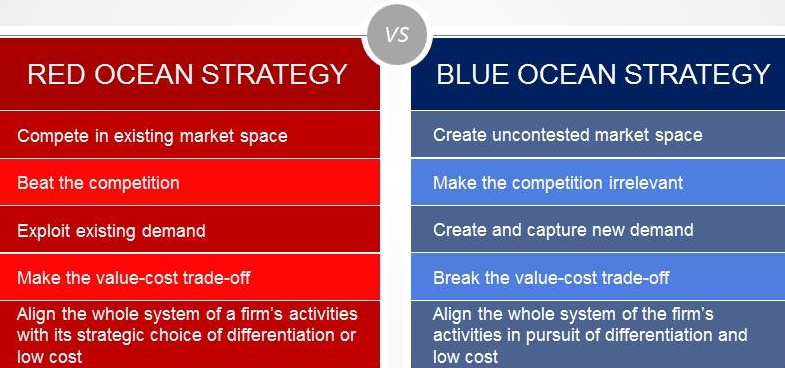- Startup Idea Matrix by Eric Stromberg
- Ideas are more valuable than money
- Blue Ocean strategy
- How to brainstorm startup ideas: techniques and tools
- Why is it so important to validate a startup idea?
- Check-list: review your startup idea for validity
Startup Idea Matrix by Eric Stromberg
Ideas are the new currency of the 21st century. Sometimes they are more valuable than money.
For example, the well-known story of Mark Zuckerberg turning down Yahoo’s offer of $1 billion. He would’ve made $250 million, but rejected it in ten minutes’ time. As Peter Thiel put it: ideas were more valuable to Mark than money.
However, there is always the question of how to create good ideas, sell them and negotiate the highest value for them. Eric Stromberg (head of Google Play) has made up the Startup Idea Matrix that, as he claims, “outlines various consumer markets as well as tactics a company can take to bring a unique product to the market”.

Follow this link to view the full B2C matrix
Follow this link to view the full B2B matrix
Anyone can look through it and get some inspiration and, what is more important, ideas for the startup not only on the Internet but also in the offline business.
Ideas are given in the columns of the table, and the consumer markets are shown in the rows with the well-known examples in between.
The author of the matrix notes that it is very prudent to be patient in finding your business idea, market, or opportunity.
Ideas are more valuable than money
As you can see, in nowadays reality, simple ideas are the basis for the success of many companies. For example, Instagram has created a photo service only for smartphones. Nowadays 1 billion people use Instagram every month.

The founder of Evernote Stepan Pachikov has decided to transfer an offline activity into an online one by creating a web service and software set for making and storing notes. In just 5 years, there were 65 million Evernote users. Or the most spread tactic – making a paid product free – has helped Udacity, Coursera and EdX to make a revolution in education by providing free online courses for everyone. That’s not the whole list! And anyone can take a cue from these companies and fill the empty cells!
“Think of this less as a map and more as a starting point for creativity.” – Eric Stromberg
At the beginning of the article, we gave an example showing that certain ideas are more valuable than money. Guess why? Well, everyone loves a good rags-to-riches story! A brilliant yet simple idea is behind each and every such story! Need proof?

The very same Zuckerberg being a student came up with the idea of a “hot or not” type of website called Facemash. It was the first step in his journey to the well-known Facebook. Zuckerberg is now worth over $35 billion.

Students are very inventive! Just like Facebook, Google was also created during the college years. Larry Page and Sergey Brin came up with the idea of a unique search engine. Now Google has more than $66 billion in sales and continues to grow by developing the other businesses. Page and Brin are now each worth almost $30 billion.
But don’t even think that only students can become billionaires. Jeff Bezos was working at a Wall Street firm before he realized that he wanted to launch his own online bookstore. Now Amazon sells everything you can think of. It’s worth about $200 billion with over $88 billion in annual sales. Bezos is now worth over $150 billion.
Check-list: review your startup idea for validity
Blue Ocean strategy
Need something else for inspiration? Well, there is a great book “Blue Ocean Strategy” by W. Chan Kim and Renée Mauborgne. You should definitely read it, it will be a great investment in yourself. The approach that is described in this book is very simple: to create something new all you need to do is just mix two spheres or two working ideas. You can do it endlessly.

So using this approach in the ideas matrix described above, you can generate tons of options. But do not forget to validate the ideas before launching them!
The second simple approach this book suggests taking the existing solution and improve it. Of course, you’ll plunge into the world of competition and of a constant race for victory, but if you are really good at what you do and run well in front of your competitors – go ahead!
And the last point of this strategy: by challenging the traditional view of who can and should be the target customer, a brand often finds new ways to offer the customer the desired value. For example, consider how Canon copiers created the small desktop copier industry by targeting users rather than corporate buyers.
We can continue listing the famous companies that have had a huge success with one simple idea. Moreover, using these matrixes anyone can develop their own idea and fill the empty cells in these tables! In addition, they may help you analyze the profit that certain ideas can bring and the most demanded niches that are starving for tasty ideas.
How to brainstorm startup ideas: techniques and tools
Brainstorming new business ideas can be done either on your own or in a group. The goal is to create as many ideas as possible, which can be analyzed in detail for their viability and compliance with your life goals.
Here are 6 techniques to help you productively brainstorm new startup ideas.
1. Define your motivation
Let’s say you want to build a hobby-based business. Or organize a lifestyle that depends on your geographic location. Or make your part-time employment full-fledged with a stable large income. Next, answer the question: what business will help you achieve this personal goal? Create a table and in the first column write the goals and the ideas of the business leading to their achievement in the second. Based on this you can build your idea matrix.
2. Imagine you have unlimited time and money
Usually, we discard bold thoughts because we’re mindful of the lack of resources and the present conditions of life. The brain has a natural tendency to quickly judge and discard business ideas and identify them as stupid and untenable. While conducting brainstorming startup ideas, try to fantasize without limits, opening up to meet all the potential ideas as if you have everything in abundance. Think boldly and big: if you could build any business, what would it be?
Write down all the ideas in your startup matrix, no matter how crazy or ghostly they may seem. The secret is that the craziest thoughts can lead to other, more realistic ideas.
3. Spend time in your client’s shoes
It’s a mistake to make a decision about launching a startup based only on the opinion of business owners. It’s important to understand the point of view of potential customers, and only those ideas for startups that take into account the needs and pains of the target audience will find a response. To get a better understanding of your consumer’s world, you can make a survey or conduct deep research, which will help to test your hypotheses. Also, you should trace all the points of consumer’s interaction with your product/service such as marketing, sales, purchases, technical support. By looking at this contact through the eyes of your target audience, you can generate many ideas to improve the customer experience.
It’s important to understand a startup in the context of its use from all sides. A specific using case will give you a simple, linear vision of this process.
4. Building a business idea matrix: describe your target market
Brainstorming around the specifics of targeted markets leads to interesting ideas about the characteristics of the future product. We would advise you to create a cloud of associations that describe the behaviour and traits of your consumer. This will help you to see how you can improve your startup.
5. Quantity is more important than quality
Remember that brainstorming is just a field for generating ideas. This creative thinking process isn’t aimed at evaluating ideas for validity. The task of the moderator is to manage the brainstorming participants to share all their thoughts.
6. No criticism, including constructive and professional
In brainstorming, it is important to be able to “turn off” your background, professional point of view, and fears. These are all limiting factors at this stage. The step-by-step and rigid structure of brainstorming can also limit thinking. Vice versa, bursts of creativity can play into your hands.
Use these tools to build your startup idea matrix
Don’t ignore the tools that will enhance your creativity. You will need the following things to help you capture your ideas and evaluate them against different criteria:
- Notebook. Capture and store all ideas in one place. All developments will be at hand, they’ll be able to stimulate the birth of new ideas in the future. Also, you can return to them after brainstorming.
- Colouring markers. The use of different colours is important both for the aesthetic component of brainstorming and for systematization and differentiation of ideas.
- Whiteboard or flipchart. Especially important in the case of group brainstorming. You want to get enough room so as not to save space in the creative process.
- Adhesive stickers. Their advantage is that they can be moved to other surfaces.
You will get a flexible map of your creative process. - Recorder. Formulate the thought out loud before writing it down on a notebook or on a whiteboard. Discussing your ideas with your partner helps to concretize the direction of your thinking, stimulates the emergence of derivative ideas.
Of course, after brainstorming, the real work begins: auditing the industry, communicating with clients, studying its history, and understanding weak points to validate an idea.

Why is it so important to validate a startup idea?
So, let’s say you successfully did brainstorming and got some startup ideas at the end. What’s next? Are you ready to throw all your energy and resources into starting a new business?
Wait, there is one more intermediate stage – checking your startup idea for viability. Why is it so important?
It helps avoid creating a wrong product
You need to understand the market, demand, cost and the essence of the competitor’s offer. Otherwise, a waste of resources, already limited in case of small startups, is possible. Preliminary research can save you money and upgrade your business area awareness.
You will learn about similar solutions, success stories and failures, be able to choose the right market and tailor your solution to your target audience.
Shows whether the market needs your product
Idea validation is a preliminary assessment of the feasibility of a product when you try to understand what the problem is in the markets and whether your solution allows you to solve it. You choose your target audience and check if they need your solution. Methods: focus group, communication with people who are your target audience, collecting feedback.
Preliminary research will help you to pitch your startup to investors
Investors need to understand that there is a demand for your product. It is not enough to have a solution to the problem. It is important to show that this solution is also feasible and better than existing alternatives and that people are ready and willing to use it.
A lot of theory, you might think, but how do you make this test of a business idea for viability? We’ve prepared a checklist for you that can help you to test the idea. Download right now and draw the right conclusions.
And remember that S-PRO experts are ready to discuss with you the idea of your startup and help in its implementation.

















